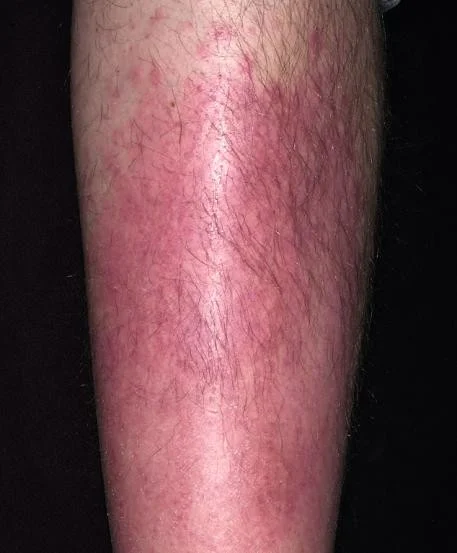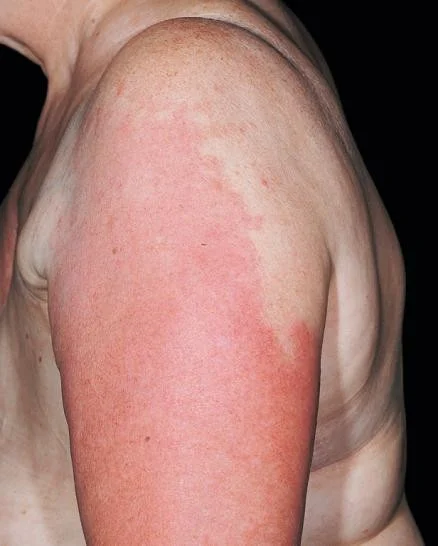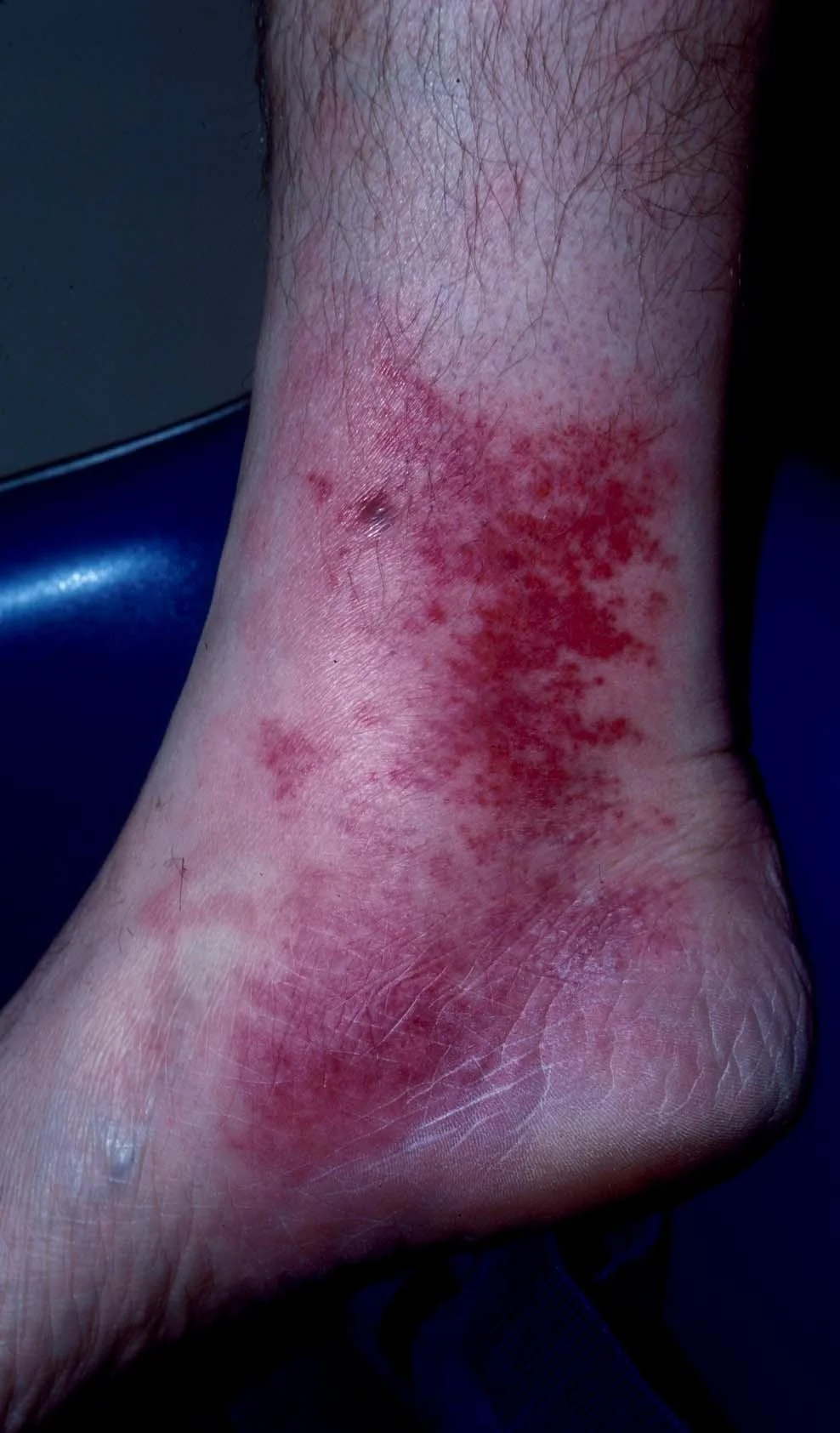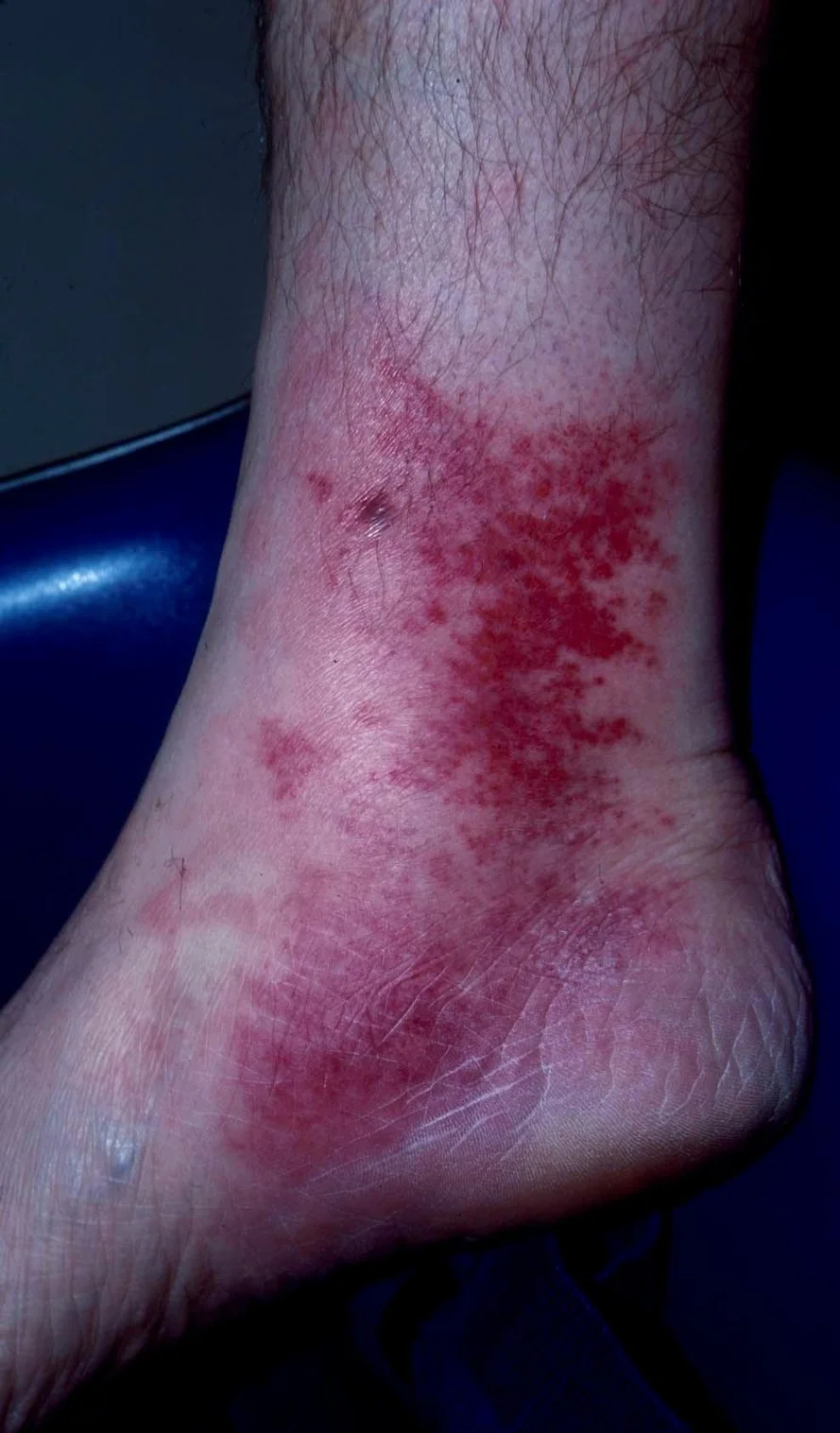Surgery
Cellulitis
A spreading inflammation of connective tissues due to group A β-haemolytic Streptococcus, Streptococcus pneumoniae or Staphylococcus aureus
Usually affects the skin on the lower legs,
other areas: can occur in the face, arms and other areas. Accompanied by inflammation of the draining lymphatics (lymphangitis) and the draining lymph nodes (lymphadenitis). There may also be associated septicaemia.
Treatment:
- Immobilisation with elevation.
- Drainage of any residual but recurrence is common.
- Antibiotic therapy as cefazolin, cefuroxime, ceftriaxone, nafcillin, or amoxycillin. Clindamycin or vancomycin in allergic patients

Dermatology
Cellulitis
- The subcutaneous tissues are involved and the area is more raised and swollen, and the erythema less marginated.
- malaise, chills, and fever.
- Cellulitis often follows an injury and favours areas of oedema.
- group A streptococci are the responsible organisms.
- Erysipelas is a superficial cellulitis.
Cellulitis: There is erythema, edema, and tenderness.


Treatment
- Elevation and rest.
- systemic antibiotics oral or I.V.
- Recurrence after antibiotic treatment occurs in 18% to 30% of cases.
Cellulitis
- Cellulitis is a very common infection occurring in up to 3% of people per year
- Results from an infection of the dermis that often begins with a portal of entry that is usually a wound or fungal infection (e.g., tinea pedis)
- Presents as a spreading erythematous, non-fluctuant tender plaque
- More commonly found on the lower leg

Risk Factors
- Risk factors for cellulitis include:
- Local trauma (bug bites, laceration, abrasion, puncture wound)
- Underlying skin lesion (furuncle, ulcer)
- Inflammation (local dermatitis, radiation therapy)
- Edema and impaired lymphatics in the affected area
- Preexisting skin infection (impetigo, tinea pedis)
- Secondary cellulitis from blood-borne spread of infection, or from direct spread of subjacent infections (fistula from osteomyelitis) is rare
Etiology
About 80% of cases are caused by gram positive organisms:
- Group A streptococcus
- Staphylococcus aureus are the most common causal pathogens
Treatment
- It is important to recognize and treat cellulitis early as untreated cellulitis may lead to sepsis and death
- Broad spectrum antibiotic
- Elevation of the involved area
Case One
History
- HPI: Mr. Nwaf is a 55-year-old man who presents with 5 days of worsening right lower extremity pain and a red rash. He reports recent fevers and chills since he returned from a camping trip last week.
- PMH: arthritis
- Medications: occasional NSAIDs, multivitamin
- Allergies: no known drug allergies
- Family history: father with history of melanoma
- Social history: lives in the city with his wife, two grown children
- Health-related behaviors: no alcohol, tobacco or drug use
- ROS: negative
Exam
- Vital signs: T 100.4, HR 90, BP 120/70, RR 14, O₂ sat 97% on RA
- Skin: erythematous plaque with ill-defined borders over the right medial malleolus. Lesion is tender to palpation. With lymphatic streaking (not shown).
- Tender, slightly enlarged right inguinal lymph nodes (not shown)
- Laboratory data: Wbc 12,000 (75% neutrophils, 10% bands), Hct 44, Plts 335

Question 1
- What is the most likely diagnosis? a. Bacterial folliculitis b. Cellulitis c. Necrotizing fasciitis d. Stasis dermatitis e. Tinea corporis
Question 1 - Answer
Answer: b
- What is the most likely diagnosis? a. Bacterial folliculitis (Would expect pustules and papules centered on hair follicles. Without systemic signs of infection) b. Cellulitis c. Necrotizing fasciitis (Would expect rapidly expanding rash, usually appears as a dusky, edematous, red plaque) d. Stasis dermatitis (Although found in similar location, stasis dermatitis often presents with pruritus and scale, which may erode or crust. Without fever or elevated wbc) e. Tinea corporis (Would expect annular plaque with elevated border and central clearing. Painless, without fever or elevated wbc)
Diagnosis: Cellulitis
- Cellulitis is a very common infection occurring in up to 3% of people per year
- Results from an infection of the dermis that often begins with a portal of entry that is usually a wound or fungal infection (e.g., tinea pedis)
- Presents as a spreading erythematous, non-fluctuant tender plaque
- More commonly found on the lower leg
- Streaks of lymphangitis may spread from the area to the draining lymph nodes
Cellulitis: Risk Factors
- Risk factors for cellulitis include:
- Local trauma (bug bites, laceration, abrasion, puncture wound)
- Underlying skin lesion (furuncle, ulcer)
- Inflammation (local dermatitis, radiation therapy)
- Edema and impaired lymphatics in the affected area
- Preexisting skin infection (impetigo, tinea pedis)
- Secondary cellulitis from blood-borne spread of infection, or from direct spread of subjacent infections (fistula from osteomyelitis) is rare
Cellulitis: Etiology
- 80% of cases are caused by gram positive organisms
- Group A streptococcus and Staphylococcus aureus are the most common causal pathogens
Question 2
- What is the next best step in management? a. Apply topical antibiotics b. Apply topical steroids, compression wraps, and encourage leg elevation c. Begin antibiotics immediately with coverage for gram positive bacteria d. Order an imaging study
Case One, Question 2 - Answer
Answer: c
- What is the next best step in management? a. Apply topical antibiotics (not effective) b. Apply topical steroids, compression wraps, and encourage leg elevation (this is the treatment for stasis dermatitis, not cellulitis) c. Begin antibiotics immediately with coverage for gram positive bacteria d. Order an imaging study (radiographic examination is not necessary for routine evaluation of patients with cellulitis)
Treatment
-
It is important to recognize and treat cellulitis early as untreated cellulitis may lead to sepsis and death
-
Broad spectrum antibiotic
-
Monitor patients closely and revise therapy if there is a poor response to initial treatment
-
Elevation of the involved area
-
Treat tinea pedis if present
-
Cultures from abscesses and other purulent skin and soft tissue infections (SSTIs) are recommended in patients treated with antibiotic therapy